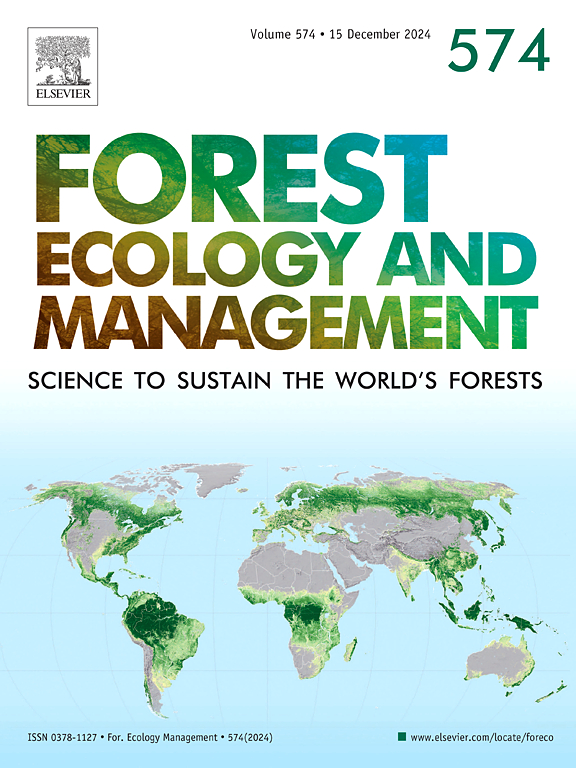Maintaining landscape connectivity for spider assemblages in temperate grasslands: The role of firebreaks in Eucalyptus dunnii plantations
IF 3.7
2区 农林科学
Q1 FORESTRY
引用次数: 0
Abstract
The Río de la Plata Grasslands have experienced significant land use and land cover changes as a result of agricultural and silvicultural conversion, which have heavily impacted natural environments. In Uruguay, large-scale afforestation has fragmented dominant grassland landscapes. Spiders, as generalist predators sensitive to environmental changes, serve as useful indicators for biodiversity studies in these fragmented environments. This study aims to understand the role of firebreaks within Eucalyptus plantations in Uruguay, hypothesizing that firebreaks might act as connectors for grassland spider populations due to their higher environmental similarity with natural grasslands. Spider assemblages were studied in a grassland-dominated landscape with commercial Eucalyptus dunnii plantations. Local environmental variables were measured, and spiders were collected with two methods —pitfall traps and G-vac (garden vacuum)— across three types of environments: grasslands, firebreaks and tree plantations. Species richness and abundance were significantly higher in grasslands compared to Eucalyptus plantations, but there were no significant differences between grasslands and firebreaks. At family level and among guilds, spider species composition in grasslands was more similar to that of the firebreaks than to that of the tree plantations. Similarity in the species composition was significantly explained by the types of environments (grasslands vs. firebreaks, grasslands vs. Eucalyptus plantations) rather than by the distance between sampling units. Overall, these findings provide new insights into the role of firebreaks in Eucalyptus plantations, suggesting that firebreaks, having environmental characteristics similar to grasslands, could serve as habitats and corridors for numerous spider species, facilitating their establishment, reproduction, and movement within the afforestation landscape.
温带草原蜘蛛群落景观连通性的维持:桉树人工林防火林的作用
由于农业和林业的转变,Río de la Plata草原经历了重大的土地利用和土地覆盖变化,这对自然环境造成了严重影响。在乌拉圭,大规模的植树造林使主要的草地景观支离破碎。蜘蛛作为一种对环境变化敏感的多面手捕食者,在这些破碎的环境中可以作为生物多样性研究的有用指标。本研究旨在了解乌拉圭桉树人工林中防火带的作用,假设防火带与天然草原的环境相似性较高,可能是草原蜘蛛种群的连接器。在以草地为主的杜尼桉商业人工林中研究了蜘蛛群落。测量了当地的环境变量,并通过两种方法——陷阱和G-vac(花园真空)——在三种类型的环境中收集蜘蛛:草地、防火墙和树木种植园。草地的物种丰富度和丰度显著高于桉树人工林,但与防火林间差异不显著。在家庭和行会水平上,草地的蜘蛛种类组成与防火林的蜘蛛种类组成更相似,而与人工林的蜘蛛种类组成更相似。物种组成的相似性主要由环境类型(草地vs防火林,草地vs桉树人工林)解释,而不是由采样单位之间的距离解释。总的来说,这些发现为桉树人工林防火带的作用提供了新的见解,表明防火带具有与草地相似的环境特征,可以作为许多蜘蛛物种的栖息地和走廊,促进它们在造林景观中的建立、繁殖和移动。
本文章由计算机程序翻译,如有差异,请以英文原文为准。
求助全文
约1分钟内获得全文
求助全文
来源期刊

Forest Ecology and Management
农林科学-林学
CiteScore
7.50
自引率
10.80%
发文量
665
审稿时长
39 days
期刊介绍:
Forest Ecology and Management publishes scientific articles linking forest ecology with forest management, focusing on the application of biological, ecological and social knowledge to the management and conservation of plantations and natural forests. The scope of the journal includes all forest ecosystems of the world.
A peer-review process ensures the quality and international interest of the manuscripts accepted for publication. The journal encourages communication between scientists in disparate fields who share a common interest in ecology and forest management, bridging the gap between research workers and forest managers.
We encourage submission of papers that will have the strongest interest and value to the Journal''s international readership. Some key features of papers with strong interest include:
1. Clear connections between the ecology and management of forests;
2. Novel ideas or approaches to important challenges in forest ecology and management;
3. Studies that address a population of interest beyond the scale of single research sites, Three key points in the design of forest experiments, Forest Ecology and Management 255 (2008) 2022-2023);
4. Review Articles on timely, important topics. Authors are welcome to contact one of the editors to discuss the suitability of a potential review manuscript.
The Journal encourages proposals for special issues examining important areas of forest ecology and management. Potential guest editors should contact any of the Editors to begin discussions about topics, potential papers, and other details.
 求助内容:
求助内容: 应助结果提醒方式:
应助结果提醒方式:


